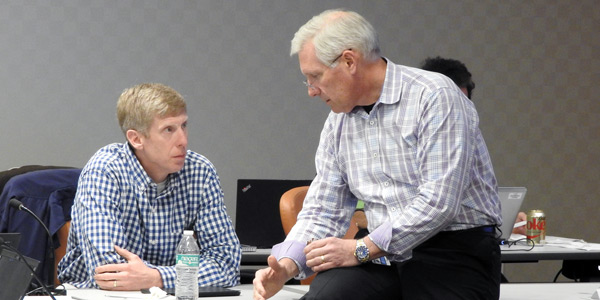By Rory D. Sweeney
VALLEY FORGE, Pa. — It took months to get PJM’s latest stakeholder initiative on the capacity market started, but there is no shortage of interest now that it’s begun.
More than 20 stakeholders attended the Capacity Construct/Public Policy Senior Task Force’s second meeting on Monday — with another 100 conferencing in — to spend more than five hours discussing 63 design-concept suggestions for revising the RTO’s capacity market.
Members agreed to form the task force in January, following months of debate on the scope of the undertaking. (See PJM to Review Impact of State Public Policies on RPM.)
Early on in Monday’s session, Steve Lieberman of American Municipal Power asked for confirmation that a suggested November timeline for deliverables is only a general target and not a specific goal. Dave Pratzon of GT Power Group suggested that such a deadline would allow revisions to be in place for next year’s Base Residual Auction.
Lieberman said the main focus should be to ensure the revisions are “complete and not half … complete.”
“There’s another word I would usually use there,” he added.
PJM’s Dave Anders, who facilitated the meeting, thanked him for not enunciating it.

PJM’s Dave Anders (right) talks with PJM’s Stu Bresler | © RTO Insider
One stakeholder noted that FERC has scheduled a technical conference May 1-2 on the interplay of state policies and wholesale markets in PJM, NYISO and ISO-NE (AD17-11). “If there is a compliance obligation that comes out of that tech conference, are we able to expand this task force to discuss it?” she asked.
Anders confirmed that the task force can vote to expand its scope in such a situation, but it must receive approval from the Markets and Reliability Committee to revise its charter. He went on to set other ground rules, including how the wide variety of stakeholder interests in this process will be handled. Instead of allowing “diametrically opposed” goals to both be approved as independent objectives of the group, he proposed using a poll to evaluate levels of support for each option.
“We’ll expose where the differences are,” he said.
Stakeholders took immediate interest in hashing out the definition of “missing money,” which NRG Energy’s Pete Fuller said should adhere to its original concept of focusing on revenue levels that support future investment, not on ensuring individual units are able to break even on a daily basis.
“It’s much more of a market-confidence stance,” he said.
Mike Cocco of Old Dominion Electric Cooperative agreed that the phrase “has lots of different meanings to lots of different people.”
To him, “missing money” means the additional revenue source from the capacity market that is necessary with a cost capped energy market to achieve the desired level of reliability. It does not mean revenue adequacy for all generators. He said the capacity market should provide the designed level of reliability at the lowest possible cost.

Burdis | © RTO Insider
PJM’s Tim Burdis provided a review of state policy initiatives that are impacting, or could impact, the RTO’s capacity market. He said such initiatives tend to fall into four categories: standards to attain, such as emissions reductions; direct contracts; appropriations such as zero-emissions credits; and regulations.
Exelon’s Jason Barker took issue with categorizing ZECs as appropriations, saying they are more closely aligned with renewable energy credits, which Burdis had categorized as “standard attainments.”
The task force’s next meeting will be April 21. The location has not been set, but Anders confirmed that it won’t be at PJM’s offices due to scheduling conflicts.


